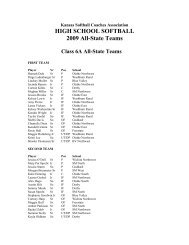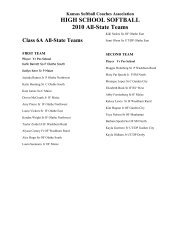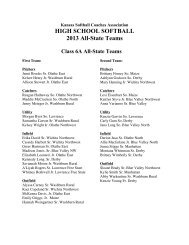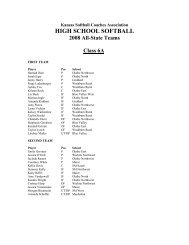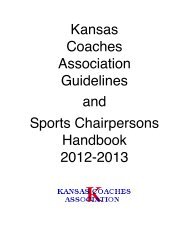Download PDF KANSAS HIGH SCHOOL GOLF RULES TEST
Download PDF KANSAS HIGH SCHOOL GOLF RULES TEST
Download PDF KANSAS HIGH SCHOOL GOLF RULES TEST
You also want an ePaper? Increase the reach of your titles
YUMPU automatically turns print PDFs into web optimized ePapers that Google loves.
<strong>KANSAS</strong> <strong>HIGH</strong> <strong>SCHOOL</strong> <strong>GOLF</strong> <strong>RULES</strong> <strong>TEST</strong><br />
The following test was developed so that the high school golfers of Kansas<br />
would have a chance to better understand the rules of golf. Many thanks to the<br />
coaches who sent their golf tests in order to develop this test. Other information<br />
was taken from THE <strong>RULES</strong> OF <strong>GOLF</strong> by TOM WATSON. Since this test is newly<br />
developed there is a possibility of errors. If you discover any errors or have a better<br />
way to word some of the questions please contact me at the address listed below.<br />
Also if you have any questions that you feel should be added to this list please send<br />
them to me. I would also like to develop a collection of rulings and/or unusual<br />
situations that have actually occurred during the course of play at golf tournaments.<br />
If you have any situations that you feel should be shared with other coaches<br />
throughout the state please send them to me.<br />
If you would like a copy of this test on a Macintosh formatted disk, (Hopefully<br />
an IBM version will be available soon) please send a blank disk along with a self<br />
addressed, stamped return envelope, to the address listed.<br />
I hope that this test is useful for you and your program. Good luck to you and<br />
your golfers!!<br />
Steve Curran<br />
During School Year:<br />
During the Summer:<br />
Steve Curran<br />
Steve Curran<br />
Girard High School<br />
704 N. Osage<br />
415 N. Summit St. Girard, Kansas 66743<br />
Girard, Kansas 66743
1 T F A player, taking relief from casual water, may not clean his ball.<br />
2 T F A player’s ball lies in a bunker. During the backswing the player’s club brushes the sand lightly. No<br />
Penalty.<br />
3 T F The margin of a water hazard extends vertically upwards.<br />
4 T F Each player should mark their ball so that they can properly identify the ball.<br />
5 T F Apron and fringe both refer to a grass area bordering a putting surface.<br />
6 T F When a player has placed their feet in position to play a ball, they have taken their stance.<br />
7 T F Through the green, a player brushes away some loose soil where they are about to drop the ball. This is<br />
not a breach of the Rules.<br />
8 _______ A ball is in deep “rough” with mud clinging to it. The player may: (A) Lift for identification only (B) Lift and<br />
clean the ball (C) Lift and clean it to the extent necessary for identification.<br />
9 T F A player’s ball lies in a bunker covered by sand. They may use a club head to search for the ball.<br />
10 T F A player deems their ball unplayable in a bunker. Under penalty of a stroke, they may remove the ball and<br />
play it at the spot where they stroked the ball into the bunker.<br />
11 T F Regardless of the type of play, if a player’s ball is moved by another ball anywhere on the course, the<br />
player’s ball must be replaced. No Penalty.<br />
12 _______ Lateral water hazards should be marked by: (A) Yellow stakes or lines (B) White stakes only (C) Red<br />
stakes or lines (D) Yellow stakes only.<br />
13 T F A “mulligan” is never permitted in a competition played strictly by the Rules of Golf.<br />
14 T F Through the green a player removes a small rock touching their ball. The ball moves. The ball is replaced<br />
with no penalty.<br />
15 T F Prior to putting from the “apron” of the green, a player using their hand, brushes aside sand which had<br />
been splashed onto the “apron”. This is permissible.<br />
16 T F The putting green may never be touched when pointing out the line to a player.<br />
17 T F A player may use their hand to bend foliage which interferes with their ability to stroke the ball fairly.<br />
18 _______ A player may, under Rule 22, have another ball lifted if it: (A) Interferes physically with their play (B)<br />
Interferes mentally with their play (C) Either A or B.<br />
19 T F A cart path interferes with a player’s stance. They may determine the nearest point of relief, no nearer the<br />
hole and drop within one club-length.<br />
20 T F A player declares their ball unplayable outside a water hazard. Their opponent disputes this claim. A<br />
referee must decide when the ball is unplayable.<br />
21 T F A dropped ball rolls and comes to rest more than two club-lengths from where it struck the ground but is no<br />
nearer the hole. The ball must be re-dropped.<br />
22 T F A player’s ball lies on a paved cart path. They may take relief on either side of the path.<br />
23 T F A player removes an out of bounds stake which interfered with their swing. This is permitted.<br />
24 T F A player from the teeing ground decides to hit a provisional ball. The player should wait until his fellowcompetitors<br />
have played thier first stroke.
25 T F Only the club head may be used to strike the ball.<br />
26 T F In stroke play a competitor’s ball rebounds from a cart path and strikes a fellow competitor. No Penalty.<br />
27 T F When a ball is out of bounds or lost, it is no longer in play.<br />
28 T F Thinking their ball is out of bounds, a player plays a provisional ball from the teeing ground. They searches<br />
for five minutes but does not find the original ball. They play the provisional ball to the hole. The original<br />
ball is then found and is not out of bounds. The original ball is in play.<br />
29 T F The line defining ground under repair is not considered ground under repair.<br />
30 T F A ball is embedded within a water hazard. A player may obtain relief without penalty under the embedded<br />
ball rule.<br />
31 _______ A ball is holed when: (A) any part of it is below the lip of the hole (B) All of it is below the lip of the hole<br />
(C) Most of it is below the lip of the hole.<br />
32 T F Prior to taking his stance, a player uses their club to break a small seedling which was immediately to the<br />
rear of their ball. They has improved the lie of his ball.<br />
33 _______ A player’s ball is covered with mud outside a hazard. They want to lift and identify the ball. The first thing<br />
they must do is: (A) Mark the spot (B) Lift his ball (C) Advise their opponent.<br />
34 T F A player leans on his putter during a round and the shaft breaks. This accidental damage could be<br />
considered as occurring during “normal course of play”.<br />
35 T F The line for out of bounds extends vertically upwards and downwards.<br />
36 T F A player’s ball lies on a movable obstruction. They may lift and drop their ball, but they may not clean the<br />
ball.<br />
37 _______ A player plays their second shot to the green, and their ball strikes the flagstick which was left lying on the<br />
green by the preceding group. What is the ruling (A) Two penalty strokes, and the ball played as it lies<br />
(B) Player replays the stroke without penalty (C) Without penalty the ball is played as it lies.<br />
38 T F From the teeing ground a player’s ball lands in a bunker and is unplayable. Under a penalty stroke they<br />
may play their next stroke from the teeing ground.<br />
39 _______ A provisional ball may be played whenever a player thinks their original ball may be: (A) Lost in a water<br />
hazard or out of bounds (B) Out of bounds (C) Unplayable or out of bounds.<br />
40 T F A flat sprinkler head on the “apron” of the green intervenes on a player’s line of putt. Relief is permitted.<br />
41 _______ A player’s ball lies in a bunker. They lean on their club in the bunker while waiting his turn to play. What is<br />
the ruling (A) No penalty because they have not taken their stance (B) Two-stroke penalty (C) No<br />
penalty because they have not addressed the ball.<br />
42 T F Information on the Rules is not advice.<br />
43 _______ A player cleans their ball when determining whether it is unfit for play. (A) Two stroke penalty (B) One<br />
stroke penalty (C) No penalty.<br />
44 T F Part of a player’s ball lies within ground under repair. The whole ball is not within such ground. Relief is<br />
permitted<br />
45 _______ A player’s ball is in excellent lie within a water hazard, but their backswing is restricted by an immovable<br />
obstruction. They may do which of the following (A) Declare the ball unplayable (B) Take relief from<br />
obstruction without penalty (C) Neither of the above.
46 _______ The whole ball rests on a line on the ground defining out of bounds. A player may: (A) Play the ball (B)<br />
Not play the ball because it is out of bounds (C) Stand out of bounds and play the ball (D) Play the ball if<br />
his stance is within bounds.<br />
47 T F A player’s ball lies in casual water in the “rough”. They are entitled to drop from casual water. The dropped<br />
ball rolls onto the “fairway”, no nearer the hole. They must re-drop in the “rough”.<br />
48 T F Strokes played with a wrong ball do not count in a competitor’s score.<br />
49 T F A player’s ball lands on the “apron” of a wrong green. They must drop within one club-length or the<br />
“apron”, no nearer the hole.<br />
50 T F A player’s ball rests against a movable bench. They may remove the bench or drop within one club-length<br />
of the spot.<br />
51 _______ A player wraps their handkerchief around the grip of their club to make a stroke. (A) Handkerchief must<br />
be removed prior to the stroke (B) This is permissible.<br />
52 T F If a competitor is doubtful of his rights, they may play a second ball in addition to their original ball. They<br />
must choose which one they will score with if the Rules permit.<br />
53 T F A player’s ball lies close to a paved cart path. They are prohibited from standing on the path to stroke the<br />
ball. They must take relief.<br />
54 _______ A player’s ball lies in a bunker. A fallen tree limb is touching the ball. (A) Player may remove the limb (B)<br />
Player may not remove limb, but they may drop another ball (C) None of the above.<br />
55 _______ A player’s ball lies in a water hazard. A hole by a burrowing animal interferes with their stance. What is the<br />
ruling (A) Play the ball as it lies (B) Proceed under the water hazard Rule (C) Either of the above.<br />
56 _______ Sand may be considered a loose impediment and removed from the line of play when: (A) On the green<br />
or “apron” of the green (B) On the green only (C) On the green or on the “apron” of the green if the<br />
player chooses to putt.<br />
57 T F The wind is an outside agency but water is not.<br />
58 T F A bird’s nest in a hazard interferes with a player’s stance. They are entitled to relief without penalty but<br />
must drop the ball in the hazard no nearer the hole.<br />
59 T F A player may not declare their ball unplayable in a bunker.<br />
60 _______ A player’s ball lies within a water hazard. he may: (A) Play the ball if it is playable (B) Drop on a line from<br />
the hole to the point where ball last crossed the margin of the hazard (C) Return to the spot he last<br />
stroked the ball (D) Do any of the above.<br />
61 _______ A player with more than 14 clubs may incur a maximum penalty of: (A) One stroke for each hole played<br />
(B) Two strokes (C) Two strokes for each hole played (D) Four strokes.<br />
62 T F A player’s ball lies on a movable obstruction within a hazard. They get no relief without a penalty.<br />
63 T F A player asks their opponent if a bunker exists beyond a dogleg of the hole being played. This is<br />
permitted because it is public information.<br />
64 T F Loose impediments are natural objects provided they are not fixed or growing.<br />
65 T F A putt stops an inch from the hole. The player then taps the ball with the grip end of the putter and holes<br />
out. This is prohibited.<br />
66 T F The outside of a stake determine the out of bounds line.
67 T F The whole ball rests on a line defining out of bounds. The ball is in play.<br />
68 T F A player’s ball is touching a water hazard stake and the ball is in the hazard. The stake may be removed.<br />
69 T F A ball is out of bounds when any part of it is out of bounds.<br />
70 _______ A player has not begun a search for their ball, but their opponent has spent 3 minutes searching for the<br />
ball. The player has ______ minutes left to search for the lost ball. (A) 2 minutes (B) 5 minutes (C) 7<br />
minutes.<br />
71 T F Equipment includes anything used, worn, carried by or for the player.<br />
72 T F There is no penalty when a player plays a wrong ball from any hazard.<br />
73 T F A player’s ball lies within an area marked ground under repair. They may play the ball as it lies.<br />
74 T F A player declares their ball to be lost without searching for it. This is a breach of the rules.<br />
75 _______ A lateral water hazard is one which is: (A) Perpendicular to the line of play (B) Out of the line of play (C)<br />
Parallel to the line of play.<br />
76 T F A player’s ball lands on a wrong putting green. They get no relief without penalty.<br />
77 T F A competitor in stoke play is disqualified if they fail to hole out before playing from the next tee.<br />
78 T F The teeing ground is two club-lengths in width.<br />
79 T F Loose impediments on the putting green may be brushed aside with a player’s hand or club only.<br />
80 T F The margin of a water hazard extends vertically upwards, but the margin of a bunker does not.<br />
81 T F A player’s ball lies near a flat sprinkler head. The sprinkler head interferes with his stance. The player may<br />
take relief without penalty.<br />
82 T F A tall weed is the “rough” interferes with a player’s backswing. Prior to the stroke, the player bends the<br />
weed out of his way. This is permissible.<br />
83 T F A player’s ball lies on a replaced divot. To preserve the course, he presses down on the area with his foot.<br />
This is prohibited.<br />
84 T F A rain shelter intervenes on a player’s line of play to the hole. It does not interfere with his intended stroke.<br />
He must play the ball as it lies.<br />
85 _______ Relief from a movable obstruction is: (A) One club-length (B) Two club lengths (C) None of the above.<br />
86 T F The flagstick is removed and placed on the putting green. A competitor putt and the ball rolls beyond the<br />
hole and strikes the flagstick. The ball shall be played as it lies and two penalty strokes added.<br />
87 T F Inadvertently, the strokes for two holes are transposed on a competitor’s card. The total is correct, but one<br />
of the holes was lower than actually taken. He is disqualified.<br />
88 T F A player is deemed to have addressed the ball when he has taken his stance on the putting green.<br />
89 T F To constitute a stroke, the club must move toward the ball, and the player must intend to strike the ball.<br />
90 _______ As a player plays a stroke the club strikes the ball more than once. What is the ruling (A) Counted as<br />
one stroke (B) Count stroke and add a penalty stroke (C) Count stroke, add two penalty strokes.
91 T F A ball overhangs the edge of the hole. The ball falls in the hole 8 seconds after it was stroked. The ball<br />
must be replaced.<br />
92 _______ After determining the proper point of relief from ground under repair, the player’s relief is limited to<br />
______ club-length(s) from the point. (A) Two club lengths (B) One club-length (C) Not more than two<br />
club-lengths.<br />
93 Y N Should I stand directly behind the player when he is addressing the ball or making a stroke<br />
94 Y N If my opponent and I decide not to count whiffs, will i be disqualified<br />
95 Y N In stroke play, do I need to finish putting if my fellow-competitor gives me the putt<br />
96 Y N May I ask my opponent for information on the Rules or Local Rules<br />
97 Y N If my ball falls off or is knocked off the tee when I am addressing it, may I re-tee the ball without penalty<br />
98 Y N May I move the ball without penalty if the ball is behind a clump of grass<br />
99 Y N Through the green, may I step on the ground behind my ball of press it down with my club head<br />
100 Y N Through the green, may I move a loose impediment such as a twig, leaf, or stone away from my ball without<br />
penalty if the ball doesn’t move<br />
101 Y N Through the green, if I play the wrong ball, may I replace it and then play my own ball without penalty<br />
102 Y N Must I re-drop my ball if it rolls nearer the hole or more than two club-lengths from the point where it first<br />
struck the ground<br />
103 Y N Through the green, should I count a stroke if my ball rolls into a new position after I have addressed it and<br />
before I have taken my stroke<br />
104 Y N If my ball is lost, must I play my next stroke as nearly as possible from the spot where I last played it and<br />
count one penalty stroke<br />
105 Y N If my ball is next to a tree so I cannot play it, is my only choice to drop within two club-lengths away from the<br />
tree and add a penalty stroke<br />
106 Y N If my ball goes out of bounds , do I play my next stroke from where it went out and count one penalty<br />
stroke<br />
107 Y N If my ball has landed against a drinking fountain, may I play it as it lies or obtain relief at the nearest point (not<br />
nearer the hole) for your stance and swing, then drop the ball within one club-length with no penalty<br />
108 Y N Do I have to play my ball out of a puddle of rain water<br />
109 Y N May I place my club head down on the ground before making a stroke in a hazard<br />
110 Y N If my ball lies in or is lost in a water hazard, is my only choice to drop a ball behind the hazard, keeping that<br />
point between myself and the hole<br />
111 Y N I am playing a ball from off the green and my ball hits an unattended flagstick, am I charged a penalty<br />
stroke<br />
112 Y N In stroke play, will I be penalized if I hit my fellow-competitor’s ball on the putting green when I am putting<br />
113 Y N Will I be penalized if I stop playing and come in when I see lightning<br />
114 Y N Are tee-markers are immovable obstructions when playing the first stroke of the hole
115 _______ Which of the following would be considered advice Asking (A) direction and yardage of the hole. (B)<br />
pin location on blind green. (C) which club the fellow competitor used.<br />
116 _______ Your ball lands on a paved cart path. You may (A) drop within one club length after obtaining relief for<br />
stance and swing not nearer the hole. (B) drop within two club lengths after obtaining relief for stance<br />
and swing not nearer the hole. (C) Play it as it lies (D) A and C above (E) B and C above.<br />
117 _______ A two-stroke penalty is incurred if the ball you hit strikes (A) your opponent or his bag. (B) you or your<br />
golf bag. (C) a dog running across the course. (D) the ball washer behind the green.<br />
118 _______ A ball is lost after you have searched for it (A) 10 minutes. (B) 7 minutes. (C) 5 minutes. (D) 3 minutes.<br />
119 _______ The ball is out of bounds when (A) most of it is out of bounds (B) all of it lies out of bounds (C) you have<br />
to stand out of bounds to play the stroke.<br />
120 _______ A player addresses the ball and starts their backswing. During the backswing the ball moves. The player<br />
continues the swing and hits the ball. What is the ruling (A) No penalty - play ball as it lies (B) One<br />
stroke penalty - play ball as it lies (C) Two stroke penalty - play ball as it lies (D) One stroke penalty -<br />
replace ball (E) Two stroke penalty - replace ball.<br />
121 _______ On the teeing area, how far behind the tee markers can a player tee up the ball (A) up to one club length<br />
(B) Six feet (C) up to two club-lengths.<br />
122 _______ When on the putting green, a player can: (A) Repair the ball marks (B) Repair spike marks (C) Remove<br />
loose impediments (D) Both A & B (E) Both A & C.<br />
123 _______ Arrange the following in order from the lowest score to the highest score: Par, Double Eagle, Birdie,<br />
Double bogey, bogey, Eagle.<br />
124 _______ Water hazards ( other than lateral water hazards) are marked by: (A) Yellow stakes or lines (B) White<br />
stakes only (C) Red stakes or lines (D) Yellow stakes only.<br />
125 Y N If a player is uncertain as to his rights or procedure, can they play a second ball and then ask the committee<br />
after the round which is correct<br />
126 _______ How many clubs are allowed to be carried in a players bag<br />
127 Y N Should a player put an identification mark on his golf ball<br />
128 T F If a player signs his score card which has a hole score higher than actually taken, then the player is<br />
disqualified for signing a wrong score card.<br />
129 T F On the day of the tournament, if the practice green is to full to practice on then a player may practice on<br />
one of the greens on the course.<br />
130 T F After a player has holed out, he may practice chipping or putting on or near the green provided it does not<br />
delay play.<br />
131 T F A player may change balls on the putting green, so that they may putt with a better ball.<br />
132 T F If a ball falls off a tee or is knocked off a tee by the player in addressing it, it may be re-teed without penalty.<br />
133 _______ A player tees from the white tee markers but should have played from the blues tee markers, he should<br />
(A) Play the ball as is and add 2 penalty strokes (B) Play the ball from within the correct teeing ground and<br />
add 2 penalty strokes (C) Play the ball from the correct teeing ground and add 1 penalty stroke.<br />
134 Y N A player wiffed his tee shot and then nervously nudges the ball off the tee before trying again, is a penalty<br />
stroke added
135 _______ If a player grounds his club in a hazard there is (A) a 2 stroke penalty (B) a 1 stroke penalty (C) no<br />
penalty.<br />
136 T F A stroke is a forward movement of the club made with the intention of farily striking at and moving the ball.<br />
137 Y N My competitor and I accidently exchange balls on a hole, I hit the wrong ball 3 times before we go back to<br />
correct the mistake. Do I count those 3 strokes on my score<br />
138 _______ My competitor and I accidently exchange balls on a hole and finish the hole. We discover the mistake on<br />
the next tee. Before we tee off we must (A) Agree that the scores shall stand and exchange golf balls<br />
(B) Add a 2 stroke penalty to each of our scores (C) Go back to where the exchange was made, add a 2<br />
stroke penalty and continue play.<br />
139 T F The penalty for fixing a spike mark in my line of putt is one stroke.<br />
140 _______ If a ball is over hanging the lip of the cup, a player is allowed enough time to reach the hole without<br />
unreasonable delay and an additional (A) 5 seconds (B) 10 seconds (C) 15 seconds.<br />
141 T F A player is on the putting green and holes a putt without taking the flagstick out of the hole. The player is<br />
assessed a 2 stroke penalty.<br />
142 T F A player hits his ball and his ball hits his bag. He playes the balls where it lies and adds a 2 stroke penalty.<br />
143 _______ A player hits his ball and his ball hits another players bag. He (A) may replay the stroke with no penalty (B)<br />
Adds a 2 stroke penalty and playes it as it lies (C) may play it as it lies (D) A and C<br />
144 _______ How many times can you drop a ball before placing it as near as possible to spot where it first struck a part<br />
of the course (A) 1 (B) 2 (C) 3<br />
145 T F Loose impediments are natural objects provided they are not fixed or growing, are not solidly embeded<br />
and do not adhere to the ball.<br />
146 T F A player shall drop the ball within two club lengths from the nearest point of relief from an immovable<br />
object.<br />
147 Y N Is a player entitled to relief from a immovable obstruction in a water hazard<br />
148 Y N Is a player entitled to relief if their ball is on a runway made by a burrowing animal<br />
149 Y N If a players ball is embedded in its own pitch mark in the fairway, is the player entitled to relief without<br />
penalty<br />
150 T F If a players ball is on the wrong putting green, they must obtain relief by proceeding to the point that is not<br />
nearer the hole and is not in a hazard or on a putting green and drop within two club lengths without<br />
penalty.<br />
151 Y N Must a player announce to the marker and/or fellow compeitior when they are going to hit a provisional<br />
ball



